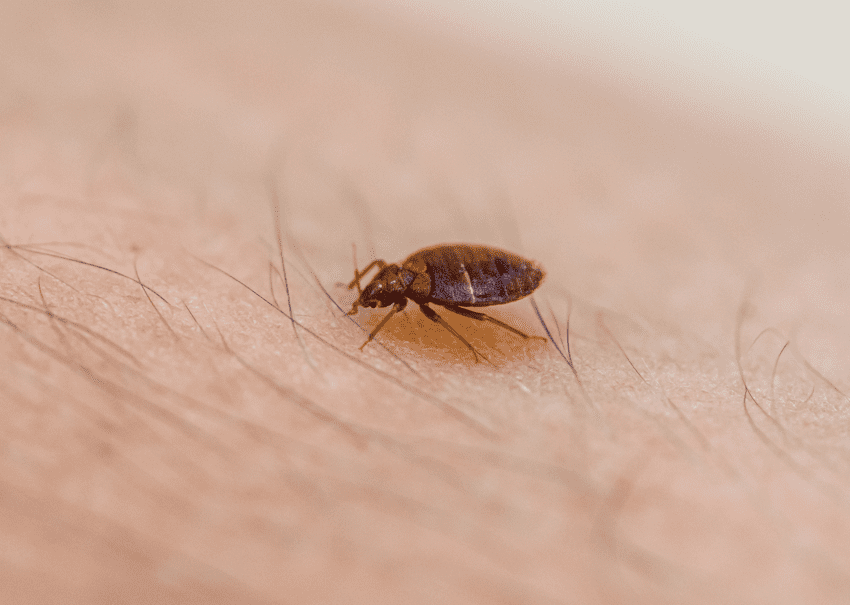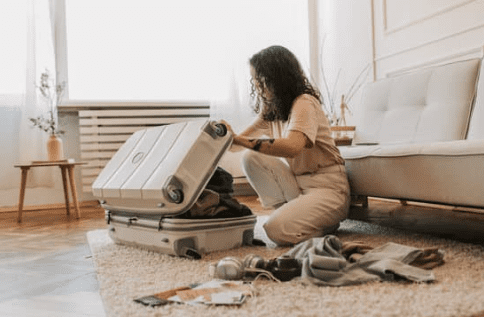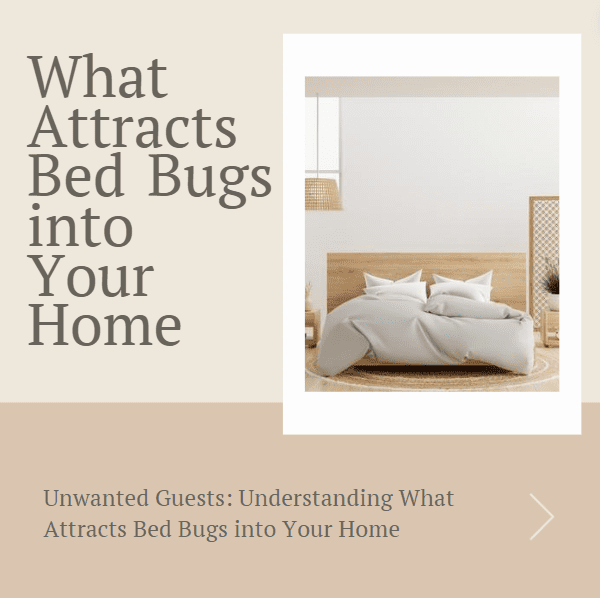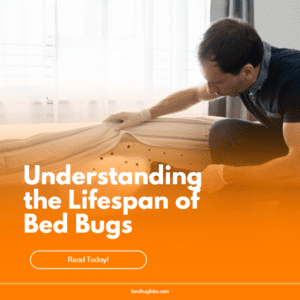Introduction
Welcome to our in-depth exploration of what lures bed bugs into your cozy corners. Transforming your sanctuary into their breeding ground. Bed bugs, those elusive, nocturnal pests, have perplexed homeowners and travelers alike with their unexpected presence. Understanding the magnet that draws these pests into our homes is not just a matter of curiosity but a crucial step in preventing their unwelcome invasion. …Click now to keep reading about Bed Bugs!
Bed bugs are attracted to environments for reasons that are often overlooked in our daily routines. These include the warmth of our bodies, the carbon dioxide we exhale, and the security of our living spaces. Our journey today will unravel these mysteries, providing you with the knowledge needed to shield your home from bed bugs. From the clothes we wear to the beds we sleep in, no stone will be left unturned as we delve into the bed bug’s world. Highlighting their preferences and the simple yet effective measures we can take to keep them at bay.
Unwanted Guests
One might wonder, “Why focus on prevention?” Simply put, the adage “an ounce of prevention is worth a pound of cure” has never been more applicable. The key to combating bed bugs lies not only in understanding their desires but also in transforming our spaces into fortresses impervious to their advances. By educating ourselves on the bed bug’s preferences, we equip ourselves with the tools necessary for a bed bug-free home.

As we embark on this journey, remember that knowledge is power. The more we understand about what attracts bed bugs, the better equipped we are to prevent them. Stay with us as we explore each factor in detail. Providing you with actionable insights to protect your home and loved ones from the clutches of bed bugs.
For further reading and to deepen your understanding of bed bug behavior. Consider visiting the Environmental Protection Agency’s page on bed bugs [EPA Bed Bugs Information]. This resource offers a wealth of information on identifying, preventing, and treating bed bug infestations. Underlining the importance of informed action in the battle against these persistent pests.
By fostering an environment of awareness and prevention, we can all contribute to a bed bug-free future. Let’s take this step together, armed with the knowledge and strategies to keep our homes safe and secure.
Travel: The Highway for Bed Bugs into Your Home
Diving into the world of travel, we uncover the unexpected role it plays as a bridge for bed bugs into our homes. These critters, savvy hitchhikers that they are, find sanctuary in the nooks and crannies of our luggage and clothing. Turning our treasured souvenirs into vehicles for their unwanted journeys. Understanding this can transform the way we approach travel, from preparation to unpacking. Ensuring we don’t inadvertently roll out the welcome mat for these pests.
The Role of Luggage and Clothing in Bed Bug Transportation
Our bags and clothes are more than just travel essentials; to bed bugs, they are first-class tickets into our lives. Hidden within the seams and folds, bed bugs travel undetected from hotels, airplanes, and other infested areas straight to our bedrooms. It’s crucial to adopt strategies that minimize this risk. Such as using protective covers for luggage and immediately laundering clothes upon return. This proactive approach can significantly reduce the chances of bed bug infestations, safeguarding our homes from these uninvited guests.
Tips for Inspecting and Managing Your Items Post-Travel
Upon returning from journeys, a thorough inspection of your belongings can be the difference between peace of mind and a bed bug nightmare. Start by vacuuming your luggage outside your home to remove any potential stowaways. Heat treatment, achieved by running clothes through a hot dryer cycle for at least 30 minutes. Is an effective method to eliminate any bed bugs that may have hitched a ride. These simple yet effective practices ensure that your travels bring back memories, not pests.

Travel plays a pivotal role in the spread of bed bugs, acting as a conduit for these pests into our homes. By recognizing the risks associated with our luggage and clothing, and implementing strategic measures for inspection and management. We can significantly diminish the likelihood of an infestation. It’s not just about where we go but how we return that defines our success in keeping bed bugs at bay. Let’s embrace these insights and strategies. Making informed decisions that protect our homes and loved ones from the unwelcome consequences of travel.
Second-Hand Bargains: Hidden Homes for Bed Bugs
Turning our attention to the cozy confines of our homes, we explore how they inadvertently become sanctuaries for bed bugs. These pests are not drawn to dirt or decay but to the warmth and security our living spaces provide. Understanding the specific areas and conditions that bed bugs find irresistible can significantly aid in their prevention. It’s not just about cleanliness but about creating environments that are less inviting to these unwelcome guests. By scrutinizing common household areas and the allure of clutter, we can unveil strategies to make our homes less appealing to bed bugs.
Common Household Areas Where Bed Bugs Thrive
Bed bugs favor areas where humans spend prolonged periods. Particularly bedrooms and living rooms, seeking the warmth and carbon dioxide we emit. They burrow into mattresses, couches, and even behind wallpapers, emerging under the cover of night to feed. Recognizing these preferred habitats is the first step in targeted prevention. Regular inspections of bed frames, mattresses, and furniture joints can help catch infestations early, preventing them from becoming established.
Understanding Why Clutter is a Bed Bug’s Paradise
Clutter provides bed bugs with numerous hiding spots, making detection and eradication more challenging. A cluttered home is a haven for bed bugs, offering them undisturbed breeding grounds. By minimizing clutter, especially around sleeping areas. We reduce the bed bug’s options for concealment, making our preventive measures more effective. Adopting a minimalist approach not only simplifies cleaning and inspection routines but also significantly lowers the risk of bed bug infestations.
The environments we create within our homes play a significant role in attracting bed bugs. By focusing on the areas where bed bugs thrive and addressing the issue of clutter, we can implement effective strategies to deter these pests. It’s a proactive approach, emphasizing prevention through awareness and environmental management. Let’s commit to maintaining vigilant and clutter-free homes. Thereby reducing the likelihood of bed bug infestations and ensuring our living spaces remain sanctuaries for us, not for pests.
Cozy Dwellings: The Bed Bug’s Preferred Habitats
The intriguing allure of carbon dioxide (CO2) to bed bugs offers a fascinating glimpse into how these pests navigate towards their next meal—us. It’s our very breath that becomes a beacon, guiding bed bugs to their human hosts under the veil of night. This biological draw underscores the importance of understanding the subtler aspects of bed bug attraction and highlights innovative strategies to minimize our vulnerability while we sleep. By dissecting the relationship between human breathing and bed bug infestations. We can adopt preventative measures that protect us during our most defenseless hours.
How Human Breathing Attracts Bed Bugs
Our exhalation of carbon dioxide serves as a dinner bell for bed bugs, signaling the presence of a nearby host. These pests are equipped with receptors tuned to detect the CO2 we emit, guiding them to their next blood meal. This attraction mechanism explains why bed bugs often find their way to our beds. Where we spend hours in a state of rest, continuously exhaling CO2. Recognizing this link is vital in formulating strategies to reduce our attractiveness to these nocturnal feeders.
Strategies to Minimize Bed Bug Attraction While Sleeping
To counteract the attraction bed bugs have to CO2, consider adopting sleep practices that reduce your exposure. Using bed bug-proof encasements for mattresses and pillows creates a barrier that bed bugs cannot penetrate. Maintaining a cooler room temperature can also help, as it reduces the metabolic rate and, consequently, the amount of CO2 produced while sleeping. Additionally, strategic placement of CO2 traps around the bed can divert bed bugs away from sleeping areas. Offering a non-chemical method of monitoring and controlling potential infestations.
The invisible trail of carbon dioxide we leave with every breath is a subtle invitation to bed bugs, drawing them ever closer to us. By understanding this dynamic, we empower ourselves with the knowledge to implement practical solutions that disrupt this attraction. Enhancing our protection against bed bug infestations. Embracing these strategies can lead to more peaceful nights, free from the concern of unwelcome bed bug visitors. Let’s breathe a little easier, knowing we’re taking proactive steps to keep bed bugs at bay, one breath at a time.
The Lure of Carbon Dioxide: Breathing Life into Bed Bug Infestations
The warmth and safety of our homes do more than just provide us with comfort. They create an inviting environment for bed bugs. These pests are drawn to the heat we produce and the sheltered spaces that mimic their natural hiding spots. By understanding the bed bugs’ preference for warmth and their need for security. We can take targeted actions to make our homes less appealing to them. This approach requires a shift in how we manage our living environments. Focusing on reducing the warmth and accessibility that bed bugs seek.
The Importance of Warmth and Darkness in Attracting Bed Bugs
Bed bugs are ectothermic, relying on external sources of heat to regulate their body temperature. This biological trait explains their attraction to human warmth. Especially during sleep when our bodies are stationary and emit steady heat. Additionally, bed bugs prefer darkness, using it as cover to feed unnoticed. The combination of warmth and darkness in our bedrooms creates the perfect conditions for bed bugs to thrive. Acknowledging this can guide us in adjusting our home environments to be less conducive to their survival.
Practical Steps to Reduce Your Home’s Appeal
Reducing the appeal of your home to bed bugs involves several practical measures. First, consider lowering the thermostat at night to reduce the overall warmth of your sleeping area. While not entirely deterring bed bugs, it makes the environment less ideal for them. Regularly washing and heat-drying bed linens can kill bed bugs and their eggs, disrupting their life cycle. Using light-colored bedding can also help, as it makes spotting bed bugs easier, preventing them from going unnoticed. Lastly, minimizing hiding places through decluttering and using protective covers on mattresses and box springs can significantly reduce bed bug harborage sites.
By addressing the factors that make our homes attractive to bed bugs—warmth and safety—we can implement effective strategies to deter these pests. This proactive approach not only makes our living spaces less inviting to bed bugs but also enhances our ability to detect and manage potential infestations early. Let’s embrace these changes, creating environments that prioritize our comfort and security, free from the concerns of bed bug invasions.
Warmth and Safety: Creating an Inviting Environment for Bed Bugs
The social spread of bed bugs is a phenomenon that highlights the interconnectedness of our lives and the ease with which these pests can move through human networks. Shared spaces such as schools, offices, and public transportation serve as conduits for bed bugs, hitching rides on personal belongings to infiltrate new environments. This aspect of bed bug behavior underscores the importance of vigilance and precautionary measures in communal settings, aiming to halt the spread at its source. By understanding how bed bugs navigate through social networks. We can adopt strategies to protect ourselves and our communities from widespread infestations.
The Impact of Human Interaction and Shared Spaces on Bed Bug Spread
Human interactions and the use of shared spaces play significant roles in the propagation of bed bugs. These environments, where personal items like bags, clothing, and furniture are common, provide opportunities for bed bugs to transition from one host to another. Awareness and caution in these settings can significantly reduce the risk of unknowingly transporting bed bugs from public spaces to our homes. It’s crucial to recognize the role we play in the potential spread of bed bugs and to act responsibly to minimize this risk.
Precautions to Take in Shared Environments
Taking proactive measures in shared environments can help prevent the spread of bed bugs. Regular inspections of personal belongings, particularly after visiting places known to have high turnover or bed bug incidences, are essential. Using protective covers for bags and luggage can also deter bed bugs from latching onto our items. When in shared accommodations, such as hotels or hostels, inspecting the bed, furniture, and surrounding areas upon arrival can preempt potential exposure. Furthermore, fostering open communication about bed bug sightings in shared spaces encourages collective action and prevention.
The social spread of bed bugs, facilitated by our daily interactions and the shared spaces we frequent, poses a unique challenge in the fight against these pests. By adopting vigilant practices and taking preventative measures in communal settings. We can significantly curb the movement of bed bugs across social networks. This collective effort not only protects individual households but also safeguards our broader communities. Creating environments less hospitable to bed bugs and more conducive to human wellbeing. Let’s remain proactive and supportive, working together to keep our shared spaces bed bug-free.
Prevention and Early Detection
Prevention and early detection form the cornerstone of an effective bed bug management strategy. These proactive measures equip us with the power to stop bed bug infestations before they start or catch them in their nascent stages. Regular inspection, maintenance, and a keen eye for the early signs of bed bugs can significantly diminish the likelihood of a full-blown infestation. By adopting a consistent prevention routine and knowing what to look for, we ensure our homes remain sanctuaries, not sanctuaries for pests. This approach not only saves time and resources but also spares us the distress associated with dealing with bed bugs.
Tips for Regular Inspection and Maintenance to Prevent Infestations
Implementing a regular inspection and maintenance routine is crucial in preventing bed bug infestations. This includes checking bed frames, mattresses, and furniture for signs of bed bugs, such as small brown spots or live insects. Utilizing protective covers on mattresses and box springs can also deter bed bugs from making a home in your bed. Additionally, reducing clutter reduces hiding spots for bed bugs, making your preventive efforts more effective. Consistency in these practices is key to keeping your home bed bug-free.
Tools and Techniques for Early Detection of Bed Bugs
Early detection of bed bugs hinges on knowing what signs to look for and using the right tools. A flashlight and magnifying glass can aid in inspecting nooks and crannies where bed bugs like to hide. Sticky traps placed around beds and furniture can catch bed bugs and serve as an early warning system. Being vigilant about new itches or bites, especially if they appear in a line or cluster, can also indicate a bed bug issue before it escalates. Knowledge of these tools and techniques empowers homeowners to act swiftly, curbing infestations in their infancy.
Prevention and early detection are your best defenses against bed bugs. By integrating regular inspection and maintenance into our routines and employing tools and techniques for early detection, we can maintain bed bug-free homes. This proactive stance not only mitigates the impact of bed bugs on our lives but also fosters a sense of security and well-being in our living spaces. Let’s commit to these preventive measures, ensuring our homes continue to be the comfortable retreats they are meant to be, free from the worries of bed bug invasions.
Conclusion
In conclusion, understanding what attracts bed bugs into our homes and adopting proactive measures to counter these attractions are crucial steps in maintaining a bed bug-free environment. From the nuances of travel and second-hand acquisitions to the subtleties of human warmth and carbon dioxide emissions, we’ve explored the myriad ways bed bugs can infiltrate our lives. Armed with this knowledge, we are better equipped to implement effective strategies for prevention and early detection, safeguarding our homes against these unwelcome guests.
The journey to a bed bug-free home requires vigilance, consistency, and an understanding of the enemy’s behavior. By making our living spaces less inviting to bed bugs through regular inspection, maintenance, and the strategic use of protective measures, we can significantly reduce the likelihood of an infestation. Moreover, fostering awareness and adopting preventive practices in our daily routines and communal spaces play a vital role in the collective fight against bed bugs.
For those seeking additional resources and guidance, the Centers for Disease Control and Prevention (CDC) offers comprehensive information on bed bug biology, prevention, and control strategies. Additionally, professional pest control services can provide expert advice and treatment options tailored to your specific situation.
Let this be a call to action for all of us to stay informed, remain vigilant, and take proactive steps to protect our homes and communities from bed bugs. Together, we can create environments where we live in comfort, not in fear of the next bite. Remember, the key to controlling bed bugs lies not just in reacting to infestations, but in preventing them from happening in the first place.




